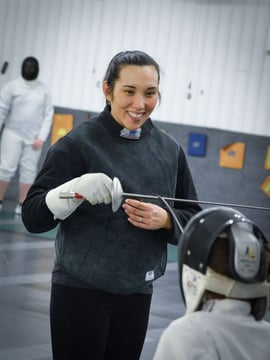Why Your Kids Should Try Fencing
An Interview with Iris Zimmermann by kidsoutandabout.com
Iris Zimmermann, Olympic foil fencer from the 2000 games, along with her sister and fellow Olympian, Felicia Zimmermann (1996 and 2000), are the co-owners of the Rochester Fencing Club. Born and raised just outside of Rochester, NY, Iris and Felicia are honored to be the first sisters ever to be inducted into the US Fencing Hall of Fame. Because fencing is clearly rising in popularity in the U.S., we asked Iris to tell us what all the fuss is about.
KOAA: What is fencing?
Iris: I think the Wikipedia entry says it most concisely: "Fencing is the martial art of fighting with blades. The common version of fencing today, also called Olympic fencing, is divided into three weapon categories: foil, sabre (spelled saber in the United States) and épée." It is a far cry from the choreographed bouts that one would see on film and screen. It is a strategic game of cat and mouse played out on a six-foot by 40-foot strip and the movements are so quick that it is scored electronically.
KOAA: Tell us about these weapons.
Iris: The foil is the weapon that most people think of when they hear the word “fencing.” It is a point thrusting weapon which means that the tip of the weapon is used to touch your opponent and score a point. It weighs less than a pound and has a flexible blade. The major differences between foil and épée are the target areas on your opponent and the shape and size of the hand guard. In foil fencing, the valid target area is the torso, front and back. The entire body is your target in épée. These differences are historically-based and date back to the time of duels. Saber is the modern version of the Calvary slashing sword, so in addition to scoring points with the tip, the side of the blade is used as well. Unlike foil, its target area includes the arms, head, and neck, going all the way from the bend of the hips to the top of the head, simulating a rider on a horse. The three different weapons have the same basic footwork, but the strategy can be quite different given the different target areas. Fencers typically specialize and train in one weapon and some coaches/clubs only teach one kind of fencing. We are fortunate at the RFC to have world-class coaches in all three weapons.
KOAA: What do kids get out of fencing? Why do it?
Iris: Fencing is a great mind and body workout and is often referred to as "physical chess." Here are what I think are the main benefits:
1. Fencing is an individual sport, so it is ideal for kids who prefer to be in control of their own success or failure.
2. Fencing requires a great deal of mental focus without realizing it. In order to be successful, you need to plan your next move and watch your opponent's moves. Because fencers are engaged in a physical activity that they enjoy, they don’t realize the amount of mental effort they are exerting. Fencing can be an extremely useful tool in training a child's ability to focus and this new-found ability can carry over into academics and other areas of the child’s life.
3. Fencers develop good hand-eye coordination, balance, and quick reflexes.
4. Fencing is a great activity for all kinds of kids, even those who may have difficulty with other organized sports. Because this sport is so unique, children are required to learn how to control their body in a way different than they ever have before. In some ways it is similar to ballet, gymnastics, or figure skating, and kids who have enjoyed these activities have transitioned well into fencing. (With fencing, though, you get a weapon!) The real advantage, however, is how this newness forces the child to have to pay attention and focus in class. This, along with the individual aspect of the sport, can be quite beneficial for children with learning disabilities or ADHD. I have seen students who have these challenges be quite successful in this activity. Every kid starts from scratch, and it isn’t always obvious what makes a fencer good.
5. Many fencers go on to complete even after high school and include fencing as a unique extra-curricular activity when they apply to college. There are many collegiate fencing programs, and while not everyone will make it to the NCAA level, many universities have club programs which allow fencers to continue this healthy, stress-relieving activity into adulthood. Top fencers can be awarded generous scholarships. For example, my sister and I both received scholarships to StanfordUniversity.
6. Finally, fencing teaches many important life lessons. In this day and age, I find that a lot of children have come to believe that everyone must be a winner all of the time. Consequently they have a hard time learning how to learn from a loss. I think fencing provides that opportunity in a safe environment so a discussion can be had and they can learn how to react appropriately and go on to set attainable goals.
KOAA: Can you tell immediately by looking at a child whether he or she will be good at fencing?
Iris: Actually, no. I think that every kid starts out on even footing (pun intended!), because everything has to be learned at the very basic level. Also, there is no body type or type of person best suited to fencing. You use your strengths for each fencing match. For example, my sister Felicia (two time Olympian) fenced by laying back and waiting for the person to come to her because she wasn't as big or strong and she liked the thrill of "beating someone to the punch". I was much more aggressive and used my physical strength as an asset. I would not give my opponent enough time to think and try to overpower them.
KOAA: What might indicate that a child might enjoy fencing?
Iris: This question is difficult. Many of our kids enjoy computer games, Legos, Lego robotics, like to learn, and have some patience to learn something new and unique. I included the last piece because it takes self-control and discipline to take the time to learn something new. As in most martial arts disciplines, fencing requires learning a lot of footwork and the basics of movement in order to master this sport. But it's a lot of fun learning this along the way. I think kids who want to use their mind as well as do a physical activity are a good fit. If someone likes to be in control of the strategy without relying on a team that also might indicate that he or she would enjoy fencing. I would like to put in a plug for fencing for girls. Because people typically think of boys as being more aggressive, some tend to think of fencing more as a sport for males. While the guys do outnumber the girls at my club, we have numerous young ladies of all ages who are thriving in this sport. Actually, up until the late 1990’s, the rules only allowed women to compete in foil. Nowadays all three weapons are equally available, and my sister, Felicia is a perfect example: She the only female fencer to win NCAA Championships in both foil and épée.
KOAA: Is fencing safe?
Iris: Fencing is extremely safe. A study of injuries occurring in Olympic competition ranks fencing as having one of the lowest injury rates, making it one of the safest Olympic sports. Only five summer Olympic sports posted lower injury rates than fencing in this study of injuries from the 2008 Olympics. (Those were: diving, synchronized swimming, rowing, kayak, and sailing.)
KOAA: At what age can kids start fencing?
Iris: 6 years old is my usual minimum, but we have started some 4-to-6-year-old classes that start with foam swords. Kids and adults can start fencing at any age, and we welcome siblings and entire families to give it a try!
KOAA: What equipment do little kids use? How about bigger kids?
Iris: The equipment is the same. Everyone uses protective gear: Chest plate Jacket Mask Glove for the hand they fence with Bigger kids that are competing are required to use knickers or fencing pants. In youth classes they only need longer pants or shorts.
KOAA: Is fencing an expensive sport?
Iris: I have been told that fencing is much less expensive than, say, hockey, but more expensive than doing a school sport. The cost at a basic level is not very expensive, but if you want to travel and compete, the costs do go up accordingly as it does with every sport. When you are first starting out, most clubs will provide all of the equipment so you can try out the sport without making a large investment. It’s only later, when kids begin to compete that they need to invest in their own equipment.
KOAA: What should parents look for when examining a fencing program? What kinds of questions should they ask?
Iris: Fencing coaches are extremely important to a fencing program. As with any martial art, the coach provides very important instruction. Coaches should be experts in the weapon they are teaching, use a sound curriculum with a logical progression of skills, have the ability to establish rapport with their students, and have a passion for fencing that carries over to the kids. Poor coaching can lead to poor habits which, if left unchecked, can make it very difficult to progress.
KOAA: What should parents expect from a first fencing lesson for their kids?
Iris: Our intro to fencing class, rec center classes, or our one-on-one lesson with a coach will go over the basics of footwork, some simple tactics and bladework, and go over the different weapons. They will be able to fence before the end of the first rec class or the intro to fenicng class to get a taste of what it is like to bout one on one with an opponent.All safety equipment is provided and included in the price of the lesson and/or class.
KOAA: If a child becomes good at fencing, what kind of dedication is required from the family for training tournaments, etc?
Iris: Many of my students start to commit to fencing somewhere between the ages of 10 and 13 years old. Some fencers travel to tournaments much earlier but our average is about 10 years old when they decide to pursue the sport almost exclusively. For a first year competitor many of the tournaments they will do will either be at the fencing club or within driving distance. For a second-third year competitive fencer at my club they will be attending more tournaments that are not at the club around 4-6 of them per year. Our upper level students attend at least one tournament a month. Practice times vary and all competitive fencers are required to take at least one lesson per week.
KOAA: Thanks so much for answering our questions, Iris, and for these great photos that you have supplied!



